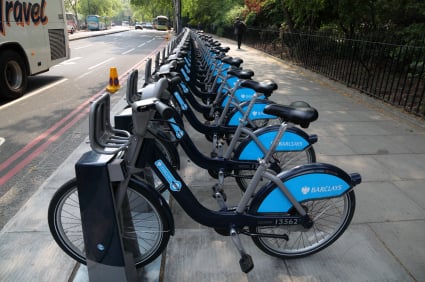London cycling facts and figures
Cycling in London Statistics
Starting in the 1960s, Britain experienced a declinein utility cycling due to increasing wealth and affordability of motor vehicles and the favouring of vehicular traffic by planners. Cycling's come back began in the 1970s[citation needed] when cycling advocates gained more concessions for cyclists and voiced ecological and social concerns about car use.
In 2007 there were more than 500,000 cycle journeys each day in the capital - a 91 per cent increase compared to 2000 - even though 2007 was England's wettest summer since 1912.[2]
As of 2008 around 2 per cent of all journeys in London are by bike: this compares to other cities in the UK such as Cardiff (4.3 per cent), York (18 per cent)[3] and Cambridge (28 per cent of commutes)[4] andto cities on the continent such as Berlin (13per cent), Munich (15 per cent), Copenhagen (23 per cent of all journeys/ 36 per cent of commutes),[5] Amsterdam (37 per cent of all journeys)[6] and Groningen (57per cent of all journeys).
In July 2010, 6,000 bicycles became available for short-termrental from Transport for London under the Barclays Cycle Hire at 400 docking stations in nine central London boroughs. This was later expanded to 8,000 cycles from 570 stations.

Cycle lane paths
On-road cycle lanes vary. Some have raised concrete kerbs that separate the cyclist from the traffic, whilst others are defined by lines painted on the road surface. The Cycle Super highways went into use inMay 2010.[7]
Cycle paths include routes through the royal parks (St.James's Park, Hyde Park, Regent's Park and Green Park), along the Thames Path and London's canals and waterways. There is a code of conduct for riding on London's towpaths.[8]
Cyclists can legally cycle in London's Bus lanes.
On road conditions
London's main roads often have heavier and quicker-moving traffic than other major European cities such as Amsterdam and Copenhagen though there is a push for 20 miles per hour (32 km/h) maximum speed limits across London.[9] There are also dangers on and along the roads such as the pedestrian railings that bedeck many London corners and streets. Because of allthese factors London's cyclists need considerably more experience and skill toride in such a challenging environment.
Vehicular cycling tactics such as don't hug the kerb are important: cyclists need to stay out of the left-most side of the road. Many deaths have occurred when vehicles pass kerb hugging cyclists and crush them against the pedestrian railings.[10] [11] Rather,cyclists need to hold their ground by riding in the middle of their lane and maintain a good pace; by doing so the cyclist maintains a high visibility and it also helps prevent vehicles overtaking within the same lane and there by forcing the cyclist to the left of the lane.[12]
Bicycle parking
As 15,000 bikes are reported stolen each year in London(though the Metropolitan Police believes the actual number closer to 60,000.[citation needed]) secure bicycle parking facilities in London boroughs are needed.
Bicycle parking is available at many Tube, mainline, tram or DLR stations.
Cycling and London's public transport
A major disadvantage of cycling in London is that (unlike some other European cities) bicycles are not allowed on many forms of public transport. The DLR and most inner London tubes do not carry bicycles; they are generally permitted on National Rail, Circle and District Line trains outside the rush hour,and certain other tube lines in outer London.[14] However, folding bicycles are allowed on all tube lines, trains and trams; they are also allowed on buses at the driver's discretion.[14]
As mentioned above bicycle parking facilities are available at many public transport hubs.
Safety
Cycling in London is sometimes perceived as unsafe so the London Cycling Campaign and Transportfor London issued guidance to minimise the risks.[15][16]
According to Andrei Morgan et al. (2010),[17] "the biggest threat remains freight vehicles, involved in more than 4 out of 10 incidents, with over half turning left at the time of the crash." Hence the London Cycling Campaign and others strongly recommend that cyclists shouldnever undertake a lorry, especially in front of red lights.[18] The correct positioning on the road is also important.[19]
Between 1986 and 2011, 439 cyclists were killed in traffic accidents in Greater London.[20] The annual number of deaths varies considerably, for example, in 2004 only 8cyclists died whilst one year later the number rose to 21. The worst year was1989 with 33 fatalities. According to Andrei Morgan et al. (2010) "the number of cyclists killed in London remains small, meaning that even if trends were present, they may not have been detected."[21]
The absolute number of deaths can be compared to the number of cycles on the road. The absolute number of bike journeys in London has roughly doubled since the 1990s, from 300,000 daily journeys in 1993 to 500,000in 2007.[22]
Andrei Morgan et al. (2010) estimate a "death rate per100,000 cyclists per kilometre per year". This number came down significantly in recent years: In 2006 it was 11.1, while the average between 1992 and 1999was 15.5. Morgan et al. estimate that this figure declined by 2.7% per year.
A map showing all cycling fatalities in Greater London since 2006 is available on the internet,[23] as well as a spread sheet containing publicly available information about thecrashes.[24]
Recent changes
The number cycling in the city of London has grown in recent years. For example, the introduction of two new "cycle superhighways"led to an increase of cycling numbers on those routes by 70% overall (one ofthe two routes actually double in numbers) within one year to 2010.[25]
Growth is assisted by governmental encouragement of cyclingand the construction of improvements to enable safe and efficient cycling.[26] Other conditions are:
Bicycle advocacy
Cost of public transport and running private cars, including the London congestion charge and petrol price increases. Safer roads for cyclists, this includes allowing cycling inbus lanes, 20 miles per hour (32 km/h) default limits, and redesign of roads to make cycling safer. Better support facilities, including parking spaces, better bicycles and gear, including waterproof bags andpanniers, better lighting, concern over terrorism on public transport networks since the 2005 bombings. In 2009 London real estate agents reported that close-bybike paths and on-site bike parking facilities were influencing the decisionsof prospective property buyers and tenants.[27]
Cycling in London
Former Mayor of London Ken Livingstone set atarget of a 400% increase in cycling between 2008 and 2025. On 9 February 2008Livingstone announced an estimated £400 million of initiatives to improve andincrease cycling and walking. To be co-ordinated by the TfL and Londonboroughs the aims include having 1 in 10 Londoners making a round tripby bike each day and five per cent of all daily trips by bike by 2025.[28]
These initiatives include:
Barclays Cycle Hire: From 2010, 6,000 bicycles were available for rental. The scheme, run by Montreal-based BIXI, will initially cover about 17 square miles (44 square kilometers) over nine central London boroughs, and will include 6,000 bikes and 400 docking stations.[29] The docking stations will be at every 300m and mainly at key destinations and tubestations (but not at any train stations) in central London. There will be a charge for hire but there will be free use to encourage the scheme. The scheme was designed based on the feasibility study produced by German Dector-Vega and Charles Snead in Nov 2008.
Extra cycle parking : There will be thousands ofnew bike parking facilities at train and tube stations.
Cycle routes: New cycle routes from inner and outer London and cycle zones around urban centres will be established, the first by 2009.This will include 12 Cycle Superhighways across central London.;[7] The firsts two pilot routes will be implemented by July 2010 and will go from Barking to Tower Hill in the East of London and from Colliers Wood to Bank inthe North. The concept was designed by German Dector-Vega and will include thetrial of cycle lanes through junctions (as in Denmark), convex mirrors at traffic signals to reduce the blind spot between lorries and cyclist (as usedin Switzerland), new signage, and the re-design of some traffic junctions to improve safety among other things.
Bike Zones: Throughout Greater London 15 Bike Zones will be created for shoppers and children going to school around"urban town centres".[30] These areas will have cycle priority streets, 20 mph limits and "quick,clear and simple" routes along roads, through parks and along side waterways. This will complement TfL's school cycle parking programme which was to add5,000 cycle parking spaces in schools by 2005.
This article was sent in by a customer - Asgard accept no responsibility for the content.












